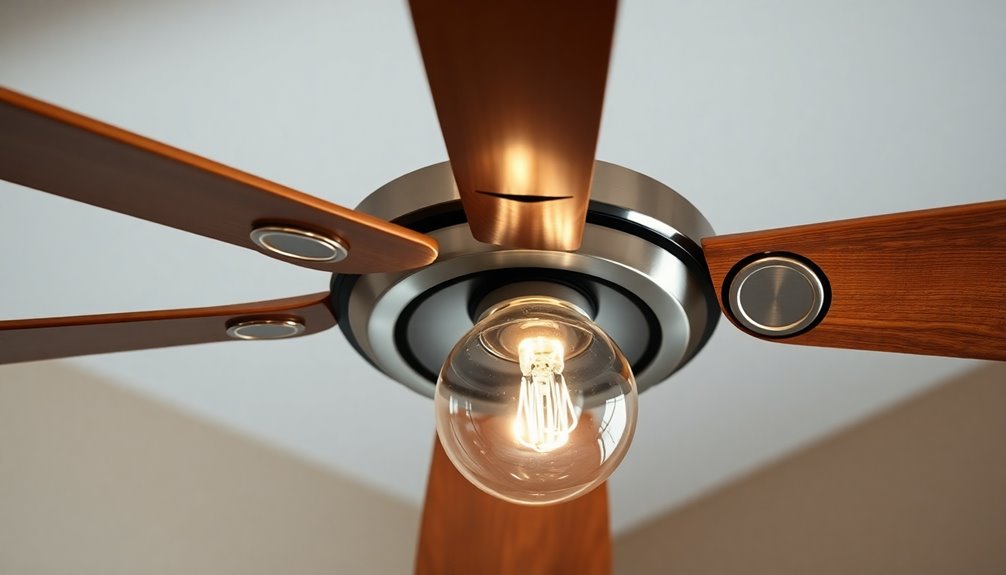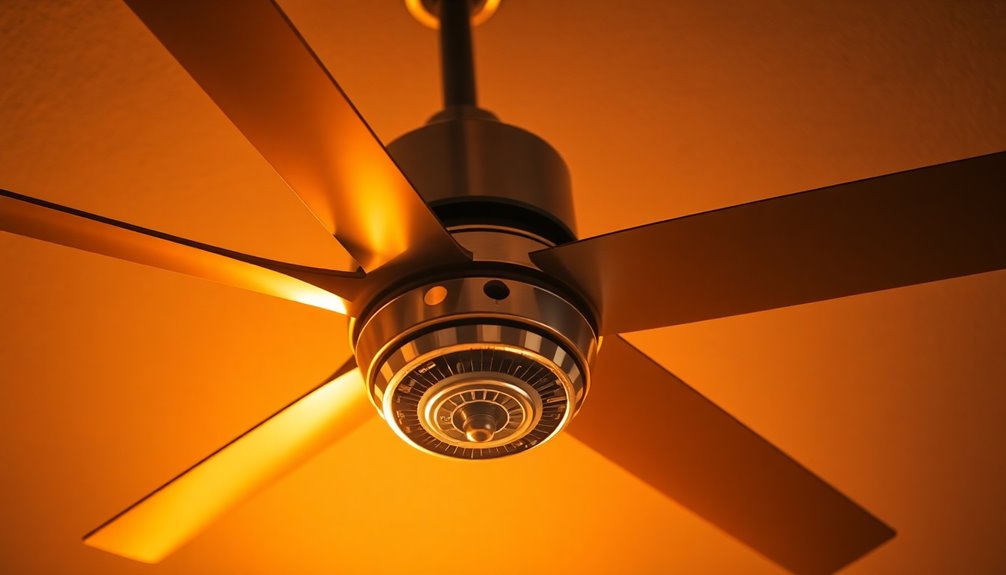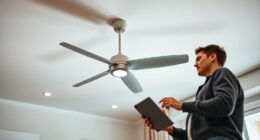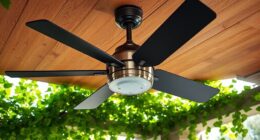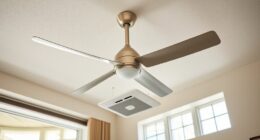Ceiling fans usually consume between 10 and 120 watts, depending on their size and efficiency. An average fan uses around 75 watts, while smaller ones, like a 23-inch fan, may only draw about 54 watts. Larger fans, such as 72-inch models, can use up to 180 watts. If you opt for an Energy Star-rated fan, it can save you about 20-30% on power costs, potentially operating on as little as 30 watts. Understanding how different fans work can help you find the best one for your space. There's more to discover about keeping those energy bills down!
Key Takeaways
- Average ceiling fans use around 75 watts, while smaller fans can consume as little as 41 watts.
- Larger ceiling fans, like 72-inch models, can use up to 180 watts.
- Energy-efficient fans, especially ENERGY STAR-rated, typically consume less than 30 watts at full speed.
- Wattage varies based on fan size and efficiency, ranging from 10 to 120 watts per hour.
- Operating costs for a typical 75-watt fan are about $0.017 per hour.
Understanding Ceiling Fan Wattage

When choosing a ceiling fan, understanding its wattage is vital for managing your energy consumption. The average wattage for ceiling fans is around 75 watts, but this can vary based on brand, size, and design.
Smaller fans, like those that are 23 inches, typically consume about 54 watts at full speed, while larger 52-inch fans average around 58 watts.
The wattage for ceiling fans can range from 10 to 120 watts per hour, depending on the fan's size and motor efficiency. This variation means you'll want to pay attention to the power used by the fan you choose.
Energy-efficient models, particularly ENERGY STAR-rated fans, often consume 20-30% less power than standard options, with some using as little as 30 watts at full speed.
Understanding the wattage of a ceiling fan is vital for calculating energy consumption and the overall cost to run it. By selecting a fan with a lower wattage, you can notably reduce your electricity expenses while still enjoying the comfort a ceiling fan provides.
Always consider energy efficiency when making your choice to maximize savings.
Energy Consumption by Fan Size

Ceiling fan size plays an essential role in determining energy consumption. The wattage of a ceiling fan varies greatly based on its size.
Here's a quick breakdown of average wattage for different fan sizes:
- 24-inch fan: Approximately 41 watts
- 36-inch fan: Around 55 watts
- 42-inch fan: About 65 watts
- 72-inch fan: Up to 180 watts
As you can see, larger fans tend to use more energy. A 48-inch fan averages around 75 watts, while a 52-inch fan operates at about 58 watts at full speed.
Although smaller fans consume less power, they often have similar operational costs to larger ones. This means that you can't always count on size alone to save on energy.
When considering energy costs, it's important to think about your specific needs and the space you're cooling. Opting for an average-sized fan might provide the best balance between energy consumption and airflow.
Calculating Ceiling Fan Costs

When you're calculating ceiling fan costs, it's crucial to take into account both wattage and fan size.
A typical 75-watt fan costs about $0.017 per hour to operate, while larger fans can use considerably more energy.
Understanding these factors helps you estimate your monthly and annual expenses more accurately.
Wattage and Fan Size
Choosing the right ceiling fan involves understanding its wattage and size, as these factors directly impact your energy costs. The average wattage for ceiling fans is around 75 watts, but it can range from 55 to 100 watts depending on the design and size.
Consider the following when selecting your fan:
- Smaller fans (36 inches): Typically consume about 55 watts.
- Larger fans (52 inches): Average around 58 watts at full speed.
- Energy Star Rated options: Can use less than 30 watts at full power, offering great energy efficiency.
- Speed settings: Larger fans perform better at lower speeds, consuming as little as 9 watts compared to 16 watts for smaller fans.
Cost Per Hour
Understanding the wattage of your ceiling fan helps clarify its operating costs, which can impact your monthly energy bills. A standard 48-inch ceiling fan typically uses about 75 watts per hour. At this average cost, running the fan will set you back approximately $0.017 per hour, or around $0.14 for 8 hours of use.
This makes the monthly operating costs for a ceiling fan range from $2.11 to $4.14, depending on how much you use it and its wattage.
If you have a larger fan that consumes around 180 watts, the cost of running it jumps to about $0.041 per hour. This higher electricity cost can greatly affect your monthly expenses.
By understanding your ceiling fan's energy usage, you can budget more effectively and potentially save money. Compared to air conditioning, ceiling fans generally offer a more economical cooling solution, making them a smart choice for energy-conscious consumers.
Daily and Monthly Usage

Over the course of a month, the daily usage of a ceiling fan can considerably impact your energy bill. If you're running a standard ceiling fan that uses around 75 watts for 8 hours a day, you might only spend about $0.09 daily. However, if you crank it up to 12 hours, that cost increases to roughly $0.24 daily.
Here's what you should keep in mind regarding monthly usage:
- A ceiling fan operating for 8 hours/day may cost you between $2.74 and $4.14 monthly.
- If used for 12 hours daily, your costs could rise to approximately $7.20.
- Larger ceiling fans that consume up to 180 watts can lead to even higher expenses.
Monitoring your ceiling fan's daily and monthly usage guarantees effective budget planning.
Understanding these patterns helps you manage your energy consumption wisely. By being aware of the average wattage and how long you run your ceiling fan, you can make informed decisions to keep your energy costs in check.
Energy Star Ceiling Fans

Opting for Energy Star ceiling fans can greatly reduce your energy consumption while keeping your space comfortable. These power-efficient fans typically use less than 30 watts at full speed, making them a smart choice for energy savings. While the initial investment may be higher, often exceeding $400 for base models, the long-term benefits are worth it. You'll see a decrease in your electricity consumption and lower energy bills over time. Additionally, many of the best home security systems also emphasize energy efficiency, which can further enhance your overall savings. Investing in energy-efficient systems not only helps in reducing costs but also contributes to a more sustainable environment. Regularly practicing self-care through energy-efficient choices can positively impact your overall well-being. Furthermore, choosing Energy Star certified products helps promote renewable energy sources, which align with sustainable energy practices.
Many Energy Star certified ceiling fans come with advanced features, like variable speed settings and improved blade designs, which enhance airflow efficiency. By choosing these fans, you're not just saving money; you're also contributing to the reduction of greenhouse gas emissions. Additionally, maintaining good indoor air quality is essential for overall health and comfort in your living space.
Here's a quick comparison of Energy Star ceiling fans:
| Feature | Standard Ceiling Fans | Energy Star Ceiling Fans |
|---|---|---|
| Watts Used (Full Speed) | 50-75 | <30 |
| Energy Savings | 0% | 20-30% |
| Average Cost | $100-$200 | $400+ |
| Environmental Impact | Higher emissions | Lower emissions |
Invest in an Energy Star ceiling fan and enjoy comfort while being eco-friendly!
Impact of Light Bulbs

When you choose a ceiling fan, the impact of light bulbs shouldn't be overlooked, as they can greatly influence your overall energy consumption. The wattage of your ceiling fan, combined with the light bulbs you select, plays an essential role in determining total wattage usage and operating cost.
Consider these factors when choosing light bulbs for your ceiling fan:
- Incandescent Bulbs: A standard incandescent bulb adds approximately 60 watts each.
- Energy-efficient LEDs: These consume only about 9 watts, markedly reducing total energy consumption. HEPA filters are an excellent example of energy-efficient technology that can enhance air quality while consuming less power. Additionally, using energy-efficient appliances can contribute to greater overall energy savings in your home. Regular use of cleaning routines can also help maintain a healthy environment, further complementing the benefits of energy-efficient lighting. Incorporating herbal alternatives in your daily routine can also promote a healthier living space, enhancing overall well-being.
- Lighting Needs: Confirm you have sufficient lighting without overloading the system.
- Long-term Savings: Switching to LED can enhance efficiency and lower your energy bills.
Additionally, using energy-efficient lighting can contribute to lower rates of depression, as studies have linked improved mood to better lighting choices.
It's important to remember that the EPA excludes light bulb wattage from EnergyGuide tags, which often leads consumers to overlook the added energy costs associated with lighting.
By calculating the total wattage usage of your ceiling fan, including the bulbs, you can make informed decisions that boost energy efficiency and reduce operating costs. Regular maintenance of your ceiling fan can also contribute to its efficiency, ensuring it operates at optimal performance.
Switching from incandescent bulbs to energy-efficient LEDs can make a noticeable difference in your ceiling fan's overall performance and cost-effectiveness.
Tips for Energy Savings

To cut down on energy costs while enjoying the benefits of your ceiling fan, you can implement several practical tips. Here's a quick guide to help you maximize your savings:
| Tip | Description |
|---|---|
| Set the Right Direction | Run your ceiling fan counterclockwise in summer for a cooling breeze, and clockwise in winter to circulate warm air. |
| Choose ENERGY STAR-rated Fans | Installing ENERGY STAR-rated ceiling fans can reduce energy consumption to less than 30 watts, greatly lowering your electric bill. |
| Turn Off When Not Needed | Remember, fans cool people—not rooms. Turn off your fan when you leave a room to save energy. |
| Keep Up with Maintenance | Regular maintenance, like cleaning blades and checking for proper operation, enhances efficiency. |
| Monitor Usage | The average ceiling fan uses about 75 watts, but with these tips, you'll guarantee it uses even less energy. |
Comparing Fan Efficiency

Understanding ceiling fan efficiency is essential for making an informed choice that meets your cooling needs without breaking the bank.
When comparing ceiling fans, consider the following key factors:
- Average wattage: A 48-inch ceiling fan typically consumes around 75 watts, while smaller models (36 inches) use about 55 watts. Additionally, diversification in investment strategies can be applied to energy-efficient appliances to maximize savings.
- Energy-efficient options: Energy Star certified fans can use less than 30 watts at full speed, considerably reducing your energy bills. Additionally, energy-efficient technology can significantly enhance the overall performance of your cooling systems.
- Performance in larger rooms: Larger ceiling fans (up to 72 inches) may consume up to 180 watts, but they often outperform smaller fans at lower speeds, enhancing air circulation.
- Operating costs: Curiously, the operating costs between small and large fans are nearly identical, emphasizing the importance of performance over size. Additionally, investing in energy-efficient models can reduce electricity bills by up to 40%, making them a smart choice for budget-conscious homeowners.
Professional Installation Benefits

When you hire a professional to install your ceiling fan, you guarantee that everything meets safety standards, cutting down on potential electrical hazards.
They also help you choose an energy-efficient model tailored to your space, which can save you money on energy bills.
With expert installation, you can trust that your fan will be securely mounted and positioned for maximum airflow.
Safety Compliance Assurance
Confirming your ceiling fan is installed correctly is essential for safety compliance and peak performance. Professional installation not only meets local safety standards but also greatly reduces the risk of electrical hazards.
By hiring certified electricians, you gain several benefits that enhance your overall experience:
- Expert assessment of your installation site for peak fan performance
- Correct wiring and mounting to minimize future repairs
- Proper wattage selection suited to your room size and cooling needs
- Enhanced warranty coverage as many manufacturers require licensed installation
When you engage professionals for your ceiling fan installation, you can rest easy knowing safety standards are upheld.
These electricians bring expertise that guarantees your fan operates efficiently, maximizing energy efficiency. You'll enjoy peace of mind, knowing that the work is done right the first time.
Plus, understanding the right wattage needed for your specific setup means you won't waste energy or incur unnecessary costs.
Investing in professional installation is a smart choice for both safety and performance, leading to a more comfortable living space without the worry of electrical issues.
Enhanced Energy Efficiency
Professional installation not only guarantees safety but also enhances energy efficiency for your ceiling fan. When you hire experts to install a ceiling fan, they confirm compliance with safety standards and optimize performance. This maximizes energy efficiency, reducing wattage usage and prolonging the fan's lifespan.
Expert electricians can recommend the best fan models and placements tailored to your space, improving air circulation and possibly lowering your energy costs. By selecting ENERGY STAR-rated fans, which consume considerably less wattage while providing effective cooling, you can further enhance your energy efficiency.
Proper installation minimizes issues like wobbling or noise, which can lead to increased energy consumption if left unaddressed. Professionals confirm that your ceiling fan is correctly connected to the electrical system, preventing inefficiencies and potential hazards.
With professional guidance, you can confidently choose the right electric motors and designs that best suit your needs. Overall, investing in professional installation not only enhances the functionality of your ceiling fan but also contributes to considerable energy savings in the long run.
Frequently Asked Questions
How Many Watts Does a 52 Inch Ceiling Fan Use?
When you're considering the energy efficiency of a 52-inch ceiling fan, it typically operates at about 58 watts on full speed.
If you opt for an energy-efficient model, it can use only 40 to 50 watts, which can really cut down your energy consumption.
At low speeds, the fan consumes around 9 to 16 watts.
Understanding these numbers helps you estimate annual energy costs, which usually range from $32 to $43 based on usage.
How Much Does It Cost to Run a Ceiling Fan 24 Hours a Day?
Imagine a gentle breeze swirling around your room, bringing cool relief on a hot day.
Running a ceiling fan 24 hours a day can cost you between $1.80 and $4.32 monthly, depending on the wattage.
That's a small price to pay for comfort! Compared to an air conditioner, you'll find your wallet stays a bit fuller.
How Much Electricity Does a Ceiling Fan Use in 24 Hours?
When you run a ceiling fan for 24 hours, it typically uses between 1.8 to 4.32 kilowatt-hours, depending on its size and wattage.
If you've got a standard 75-watt fan, you're looking at around 1.8 kWh.
This translates to a cost of about $0.18 to $0.72, based on local electricity rates.
Do Ceiling Fans Use a Lot of Electricity?
Ceiling fans don't use a lot of electricity compared to other appliances.
You'll find that they typically consume between 10 to 120 watts, depending on the model. Even if you run your fan for eight hours a day, the monthly cost can be just a few dollars.
Plus, they're energy-efficient, potentially saving you up to 30% on your cooling bills.
Conclusion
To summarize, understanding how many watts a ceiling fan uses can help you make smarter choices for your home. Like a well-tuned instrument, the right fan can create comfort while keeping energy costs low. By considering factors like size, energy efficiency, and light bulbs, you can guarantee you're not just cooling your space, but doing it wisely. Embrace these tips, and you'll enjoy a breezy atmosphere without breaking the bank on your electricity bill.



